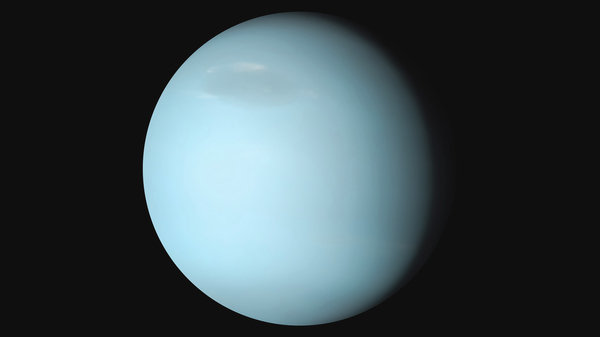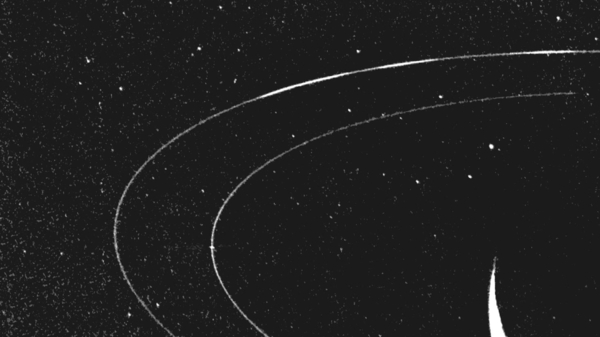Neptune: The Farthest Planet
The farthest planet from the Sun is impossible to observe with the naked eye.

This image of Neptune was taken by the Voyager 2 spacecraft during a 1989 flyby. The blue color was artificially enhanced—Neptune’s true color is a paler, greenish blue, similar to Uranus.
©NASA
Jupiter and Moon Close Approach 2024
A Brief Overview of Neptune
Neptune is the eighth planet from the Sun and the farthest known planet in the solar system. It lies on the inside edge of the Kuiper Belt, a large and rocky region of the solar system that contains the dwarf planets Pluto, Haumea, Makemake, and Eris.
Compare the sizes and order of the planets
Like Uranus, Neptune is an ice giant, with an atmosphere of hydrogen and helium, and an interior of slushy, rocky, icy material.
The greenish, bluish tint of Neptune and Uranus comes from methane in their atmospheres.
Where Is Neptune in the Sky?
Find and track Neptune with our Interactive Night Sky Map
Check the weather in your town or city
When Is the Best Time to See Neptune?
Neptune is too far away to be visible with the naked eye. However, it can be seen with a good pair of binoculars or a small telescope.
The best time of year to observe the planet is around its opposition, when it lies directly opposite the Sun in the sky. Neptune disappears from view completely around the time of solar conjunction, when it is lost in the bright glare of the Sun.
Oppositions of Neptune occur approximately every 367 days.
Next opposition: September 21, 2024
Next solar conjunction: March 19, 2025
Previous solar conjunction: March 17, 2024
Previous opposition: September 19, 2023
How far is Neptune from Earth right now?

Neptune has a faint system of rings. Voyager 2 took this close-up of the two main rings when it flew by in 1989. (Neptune is in the bottom-right corner, in a crescent phase.) The material in Neptune’s outer ring clumps together to form a series of arcs. Three of these arcs can be seen in the upper part of this image—they are the bright patches in the outer ring.
©NASA/JPL
How Long Is a Day and a Year?
Like all the outer planets, Neptune rotates quickly—its solar day is approximately 16.1 hours.
A Neptunian tropical year is about 59,780 days, which is around 164 Earth years.
How Many Moons Does Neptune Have?
To date, 14 moons of Neptune have been discovered. The largest of these natural satellites is called Triton.
Triton is unique because it is the only large moon in the solar system with retrograde rotation. This means the direction of its spin (clockwise, as seen from above the Sun’s north pole) is the opposite of its orbital direction around Neptune (counterclockwise).
Astronomers suspect that Triton used to be part of the Kuiper Belt—a region of the solar system beyond Neptune—before getting caught by Neptune’s gravity.

Triton is the seventh-largest natural satellite in the solar system, after the Galilean moons of Jupiter, Saturn’s Titan, and our own Moon.
©NASA
Human Exploration of Neptune
Galileo came close to adding another spectacular discovery to his list of achievements when he observed Neptune with his telescope in December 1612 and January 1613. However, he marked it down as a star in his notebook.
In the decades following the discovery of Uranus in 1781, astronomers noticed the new planet did not precisely follow its expected path. Urbain Le Verrier and John Couch Adams independently predicted that these differences were caused by the gravitational pull of another, unseen planet.
Using Le Verrier’s calculations, Johann Gottfried Galle discovered Neptune on September 24, 1846.
In 1989 Voyager 2 became the first—and so far only—spacecraft to visit the planet in a flyby.
How Long Does It Take to Get to Neptune?
Every 176 years or so, the solar system aligns such that the outer planets become like stepping stones. A series of gravity assist maneuvers can swing a spacecraft from one planet to another and enable Jupiter, Saturn, Uranus, and Neptune to be visited within roughly a decade.
Voyager 2 made this “Grand Tour” in the late 1970s and 1980s. It took almost exactly 12 years to reach Neptune.
Voyager 2
- Launched: August 20, 1977
- Arrived: August 25, 1989 (flyby, closest approach)
- Journey time: 12 years and 5 days
All dates are shown in UTC.